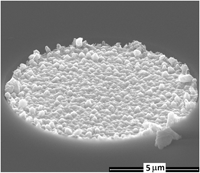Article contents
Nanoenabling electrochemical sensors for life sciences applications
Published online by Cambridge University Press: 14 August 2017
Abstract

Electrochemical sensing systems are advancing into a wide range of new applications, moving from the traditional lab environment into disposable devices and systems, enabling real-time continuous monitoring of complex media. This transition presents numerous challenges ranging from issues such as sensitivity and dynamic range, to autocalibration and antifouling, to enabling multiparameter analyte and biomarker detection from an array of nanosensors within a miniaturized form factor. New materials are required not only to address these challenges, but also to facilitate new manufacturing processes for integrated electrochemical systems. This paper examines the recent advances in the instrumentation, sensor architectures, and sensor materials in the context of developing the next generation of nanoenabled electrochemical sensors for life sciences applications, and identifies the most promising solutions based on selected well established application exemplars.
Keywords
- Type
- Invited Reviews
- Information
- Journal of Materials Research , Volume 32 , Issue 15: Focus Issue: Two-Dimensional Nanomaterials for Biosensors , 14 August 2017 , pp. 2883 - 2904
- Copyright
- Copyright © Materials Research Society 2017
Footnotes
Contributing Editor: Venkatesan Renugopalakrishnan
This section of Journal of Materials Research is reserved for papers that are reviews of literature in a given area.
References
REFERENCES
- 5
- Cited by


